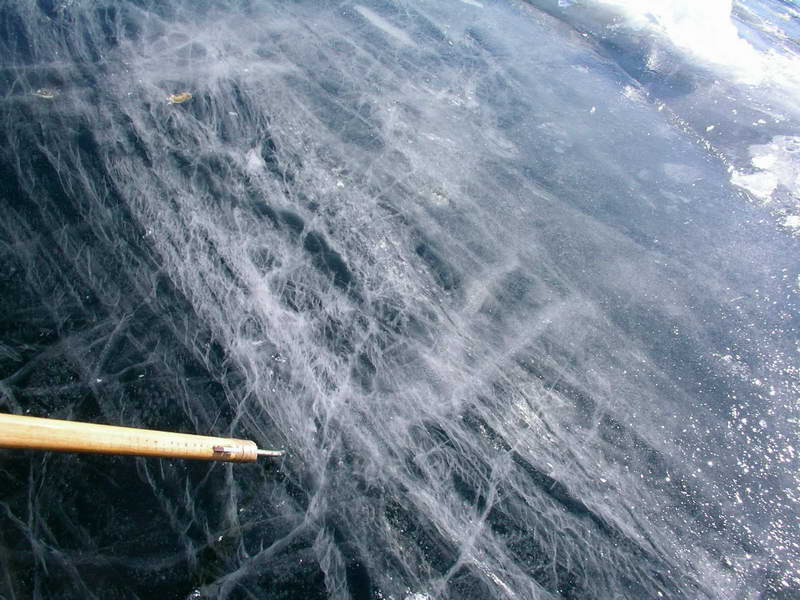Stress Cracks
 Ice full of stress cracks at the edge of a folded pressure ridge. Scale: Pole is 1-1/2" thick
Ice full of stress cracks at the edge of a folded pressure ridge. Scale: Pole is 1-1/2" thick
All cracks in ice are caused by stress in the ice. It can be local or broadly distributed across an ice sheet. The stress comes mostly from temperature changes in the ice sheet, wind and waves
Cracks come in a variety of forms:
- Tight cracks: cracks where the ice are tight together. They have some tensile strength.
- High density of tight stress cracks (see picture above)
- Wet cracks (cracks with water in them)
- Contraction cracks form when an ice sheet shrinks due to cooling. They form when the top surface of an ice sheet cools and cracks, pulling the ice sheet into a concave shape.They can be dry (thicker ice) or wet. This is the opposite of ice buldge cracks.
- Transverse cracks: wide wet cracks that run between adjacent pressure ridges
- Wide wet cracks: cracks at least several inches wide associated with a large scale shift of ice plates.
- Dry cracks with open tops
- Shear cracks (spiral cracks)
- Techtonic Cracks: when pressure ridges terminate they almost always have a crack extending in the direction of the ridge axis.
- Pressure ridges involve cracks of several types
- Ice buldge cracks: they form when the top of an ice sheet heated quickly, flexing the plate into plate into a convex shape and breaking it into pieces with a rough scale of 10-50 ft. These and contraction cracks (ice sag) are ubiquitus on unthawed black ice.
- Wave break cracks: caused by waves cracking the ice sheet into farily large pieces.
- Subsurface cracks: visible only in the lower half of the ice sheet.
- Leeds: very wide wet cracks that occur when ice sheets are being pushed around by very strong winds or when an large ice sheet has become detached and is moving into open water.
The formation of cracks accounts for the sounds ice makes. When a black ice sheet gets to be about4 to 6" thick and it warms up for the first time, there can be a LOT of noise. Cracks are especially dramatic when one runs between your legs and off to a distant part of the ice sheet. Evenings also tend to be noisy as the ice cools off.
Very new ice generally does not have many of cracks but by the time it is a few inches thick and the sheet has been through a couple warm-cold cycles they are all over the place. The thermal shock resistance of ice is lower than most other materials. The geometry of the ice sheets and the shore and thermal conductivity are other factors that come into play.
On black ice we often use stress cracks as a secondary way to verify that frozen over holes are thick enough (the primary way is usually a test pole). Sometimes these cracks only go part way through the ice sheet.
It is instinctive for most people to pay attention to cracks that form as a result of their moving over the ice. Much of the time these cracks form as a result of a combination of preexisting stress and the added stress of your weight. That is why some parts of a uniformly thick, 2" ice sheet are noisy and others are quiet. Sometimes it is because you moved onto thin ice. If you hear cracking that appears to be related to your presence, always check the ice promptly to verify that it is thick enough. Vehicles often initiate cracks on thicker ice (see Vehicles and Ice).
Thawed and snow covered ice are considerably more quiet than exposed, cold, hard ice.
As the ice gets thicker some of the cracks pull apart a little near the surface of the ice. These can catch skate blades if you happen to be going directly along the crack. A fall often results (one of several reasons why elbow and knee pads and a helmet are a good idea for skaters). If the ice is thick these gaps can be big enough to fit iceboat runners. Usually (but not always) the runner will climb back out before something breaks or gets torn off the boat.
 Steering runner on TAKU stuck in a open contraction crack on Canyon Ferry MT. The ice is about 20" thick and this area has especially high swings in temperature. TAKU is a large (heavy) stern steerer. The runner is about 30" long.
Steering runner on TAKU stuck in a open contraction crack on Canyon Ferry MT. The ice is about 20" thick and this area has especially high swings in temperature. TAKU is a large (heavy) stern steerer. The runner is about 30" long.
Revised 9/4/2013
